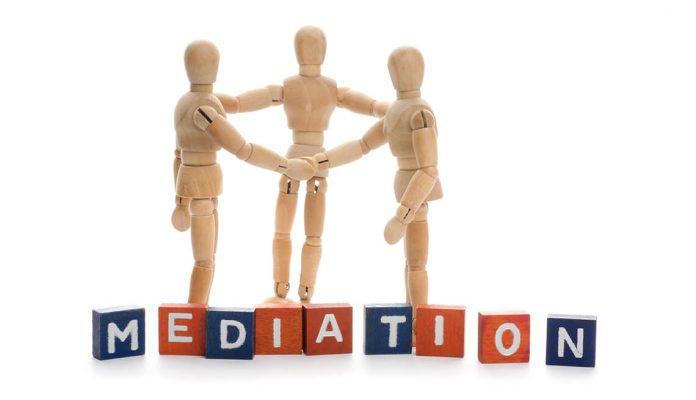This article is written by Ayushi Mahajan, from Centre for Legal Studies, Gitarattan International Business School (Guru Gobind Singh Indraprastha University). This article talks about some famous case studies on the process of mediation.
Table of Contents
Introduction
Mediation is said to be a process in which both the parties use to discuss their problems and disputes to the third party who is a trained impartial third person who assists them in reaching a settlement. Mediation is an informal meeting among the two parties which is a scheduled settlement conference.
The dispute may be either filed in the court or a pending dispute. Cases which are suitable for the mediation may include personal injury, workers compensation, commercial transactions, divorce or domestic relations, labour or community relations, employment or any other relating matters which do not involve evidentiary issues or any other matters which do not involve complex procedures. Attendance at the table of mediation conference is voluntary by both the parties, except where it is governed by the statute or contract clause.
Who is a mediator
A mediator is said to be a person with common sense, persistence and patience. He/she has many techniques of negotiations, skills of human dynamics, effective listening powers restatement and articulation. The mediator is said to be a facilitator who has the power to render the resolution to the conflicts. In many kinds of jurisdictions, the mediator is said to be an attorney but he is bound to not give legal advice while he is in the role. However, the mediator’s subject area of expertise will be beneficial by the parties in framing and wording the mediation agreement or in the circumstances where the parties are open to the neutral case evaluation.
Qualities of a good mediator
- Trust
- Neutrality
- Confidentiality
- Listen patiently
- Punctuality
- Act within corners of law
- Knowledgeable
- Optimistic
Benefits of the mediation process
To parties
There are many reasons why the parties should choose mediation over the process of other forms of litigation. Many of them are timely resolution, confidentiality, affordability, private sessions, participation in the resolution of the disputes and many other cases of preservation of the interrelationship between the parties. Another reason is that the cost of mediation is much lower than the cost of the process of the litigation. The mediator’s hourly rate is quite lower than that of the lawyer. Parties can often schedule the mediation within the weeks of a decision to mediate or a court order to mediate.
To attorneys
Mediation is said to offer an opportunity to improve the case. The attorneys want to improve the financial status of their position. They can charge regularly on the mediation table rather than in the courtrooms as there may be a lack of services on the part of judges or other lawyers, even when the case is scheduled.
How does it work
The meeting is held at a mutually agreeable place by all the parties. It can be the place at which both the parties feel comfortable or at the place of the mediator. There are stages as follows:
- Introduction – It means the introduction of the problem which both the parties are facing. The mediator will give an opening statement about the problem of the parties. It will then provide for the introduction of the mediator, his experience or other qualifications. Then they will discuss the problem they both are facing and will talk for the mutual solution at which both the parties will be comfortable.
- Problem Determination – After the introduction phase is over, the mediator will determine the basic problem of the whole discussion.
- Generation of options and alternatives – It is the phase in which both the parties and the mediator will provide for the options of the solutions to the problem which is determined at the second stage.
- Clarification and agreement writing – This is the final phase of the process of mediation. In this, the mediator will finalise the terms of the solution and then makes an agreement signed by the parties to their problem.
Case studies related to mediation
-
Acta de Brasilia negotiations between Peru and Ecuador
The dispute
This major territorial dispute is traced back to the Spanish Colonial times in 1800, which was having the last major conflict which erupted in 1942 after Peru evaded Ecuador. It was said that the shared borders of Peru and Ecuador have been the site of the great conflicts arising between the two countries. The evasion led to a 10-day war which then ended by signing the protocol of Rio de Janeiro. The description in the protocol was that it will give 200,000 square kilometres of former Ecuadorian land to Peru. While the protocol was intended to resolve the ongoing territorial dispute, the newly established boundary of the protocol was poorly defined. This resulted in continued tension, seen most prominently in the military The 1981 and 1995 clashes.
The process
There was a series of lengthy discussions, negotiations and interventions which was done through the third party help taken from the United States, Chile and Argentina and the Acta de Brasilia was signed. This positive act was done to improve the tensions between the two countries and to build corporations among them and to protect the biodiversity of both countries. Both the countries established the peace parks in the year 1999. Peru created an Ecological Protection Zone and the Santiago Comaina Reserved Zone and Ecuador created the El Condor Park. These parks give a chance to local communities to develop within those areas.
The result
There have been further cooperative acts which were signed between both the countries to maintain the conservation of the parks since the Acta de Brasilia was signed. The Acta de Brasilia has helped to resolve the territorial dispute which was there between Peru and Ecuador by promoting diplomacy across the borders and initiating the cooperation and strengthening of the relations.
-
Agacher Strip Mediation between Burkina Faso and Mali
The dispute
Where border Should have drawn enough tension between the two countries and was the source of two explosions Armed conflict, first in 1974 and then in 1985. Burkina Faso and Mali both sought to control the 100-mile-long Agatur Strip, and with it The It had a significant amount of natural gas and mineral resources. The second conflict, called the visitor The “Christmas” war lasted five days and spent dozens of lives.
The process
The Christmas war ended when the two sides of the argument signed a treaty of peace which was sponsored by the West African Political mediation group.
The result
The International Court of Justice stated the final decision by December 22, 1986. After the investigation of the decided matter, The ICJ then decided to make some minor corrections to the border treaties and gave the authorities control of the withdrawal of the troops. Key to the mediation was near to the equal division of the Agacher Strip, with Burkina Faso receiving the east portion and the Mali west.
-
Mediating Water Quality Standards in Oklahoma
The dispute
In early 2006, Oklahoma State, United States, Quapo Tribe and the American Environment The Protection Agency (EPA) Region sought to address a cooperative agreement Water quality issues in Oklahoma with the help of the US Institute of Environment Mr J. Michael Harty of Conflict Resolution and Harty Conflict Counseling and Mediation. The parties then assisted in the process of negotiations and mediations with mutuality.
The process
Mr Harty conducted an assessment of the Safe Accountable, Flexible and Efficient Transportation Equity Act of 2005 (SAFTEA).
The result
In 2007 and 2008, with the help of Mr Harty, the parties developed a number of factors. Negotiations are likely to be affected, and a process by which EPA will effectively coordinate Formation of Cooperative Agreement. Mr Harty determined that due to the tribe and Commitment of state leaders, knowledge of the subject area, and resolve to reach, Parties can effectively manage their lower-level mutual trust to align their core Interest in a cooperative agreement.
-
Washington Navy Yard Stormwater Permit Mediation
The dispute
There was a national pollutant Discharge elimination system of stormwater for Washington DC. The USA Navy Yard was then issued by the Environmental Protection Agency. As the two parties, the US Navy did not agree with the applied process of permit. A 4-year long dispute arose then.
The process
The US the institute for environmental conflict resolution which tried to manage to have the parties agree on a formal status of the mediation process to settle the dispute between the two parties. The settlement of the mediation only took 5 months to finalize the process and come to an end.
The result
The mediation process ended a 4-year-old dispute which was there between both the parties. After the dispute, an agreement on the environmental protective permit was agreed and signed upon both the parties and that was on both sides’ interest.
-
Lake Michigan – USA Mediation
The dispute
The Federal Government of the US has been in conflict over the use of Lake Michigan’s Water since the beginning of the 20th century. Removal of too much water critically affects the lakes in the other states. This dispute led to more than the 4 US Supreme Court cases between 1920 and 1995.
The process
In 1995, when the US Supreme Court litigation on the issue arose, the eight great states and the US government came into the mediation. They decided the cost to split thereof. In less than 1 year, the parties produced a framework to permanently settle the arisen dispute.
The result
The agreement was in the form of a memorandum of understanding which was signed by all the eight states and was announced on October 9, 1996.
-
Apple timber sale in Oregon
The dispute
The residents of the Williams, Oregon USA, initiated the dispute by filing a case against the US Bureau of Land Management (BLM) over the apple timber sales in their community.
The process
At the request of both the parties, The US Institute for Environmental Conflict Resolution contracted the mediators in an attempt to settle the issue that arose outside the courtroom proceedings. The mediators in conjunction with both the parties counsel and determined the negotiation to take place and then made the recommendations.
The result
After the process of mediation was over, both the parties came to the final agreement concerning the sale of Apple timber in Oregon. The agreement allowed 75% of the original sale to be executed, while 25% was still left untouched. Additionally, it then afforded the community members the opportunity in having the oversight over their town’s lumbering activities.
-
Sun River Watershed Management Collaboration
The dispute
The sun river flows 110 miles Through west-central Montana, USA through the forests, Mountains and many communities before emerging into the Missouri River. The Sun River Watershed covers 1.4 million acres and provides water for the irrigation districts, ranchers and fisheries.
The process
With the joint efforts of the evaluators, the USIECR and the Sun River Watershed Group, an atmosphere of mistrust and hostility that thwarted previous attempts to cooperate and resolve the many issues of the disappearance of the Sun River. Ways to manage more efficiently Reservoirs of watersheds were researched and recommendations made to help reduce pollution discussed.
The result
As a result of these efforts, significant progress was made. Accomplishments include: Half of a 40 Mile stream segment that was considered the worst nonpoint source issue in Montana Stabilized by reducing sediment load by 80%; Four miles of primary fisheries and spawn habitats were restored; Prescriptions for grazing management were applied to 50,000 acres of rangeland; Automatic duct gates were installed, which increased water control and efficiency.
Conclusion
Mediation is being used to help people settle everything from school disputes to international conflicts. It works because it enables people to listen to each other and settle their disputes in a safe environment with neutral support. It works because it emphasizes crime and punishment and emphasizes planning and understanding how people will get in the future.
This works because most people in conflict (and in this case, their employer as well) are motivated to take the fight to another level (e.g. court), which inevitably brings with a lot of costs, too much hostility. Is, damages relationships, and risks embarrassing public scrutiny. Mediation in the workplace deals with conflict in the most sensible and effective way, with it being private and inexpensive. It’s good business.
References
- https://www.mediate.com/articles/bertschlerJ1.cfm
- https://mediatorsbeyondborders.org/wp-content/uploads/2012/10/MBB-Climate-Change-Project-Case-Summaries.pdf
- https://corporate.findlaw.com/litigation-disputes/what-is-mediation-and-how-does-it-work.html#:~:text=Mediation%20is%20a%20procedure%20in,or%20a%20scheduled%20settlement%20conference
LawSikho has created a telegram group for exchanging legal knowledge, referrals and various opportunities. You can click on this link and join:











